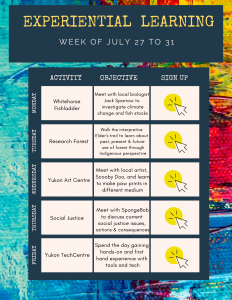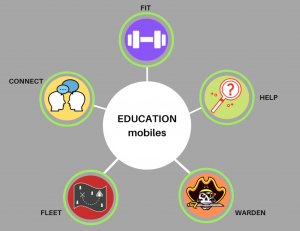What if….?
Here are two scenarios for speculative future for education in 2050 based on my imagination. I found this task to be by FAR the most difficult of ETEC 540! The longer I worked on it, the more I realized that it has aspects that could be instituted much sooner than the thirty-year guideline set out in the task. However, this would require visionary leadership and a progressive-thinking community, not to mention infrastructure, resource and financial increases.
I fully agree with Shannon Vallor (2018) that Artificial General Intelligence (AGI) will be a long time off, and I personally believe that students will continue to need human characteristics in others that cannot be replaced by AI, as Vallor states, AI “don’t love and don’t care”. For example, Harari (2017) uses the comparison of doctors and nurses to say that doctors could be replaced by AI sooner than nurses because their skills are mostly information processing and diagnosing, whereas nurses need more motor skills for first aid-type, hands-on care and soft skills, involving emotion and compassion. Although I think this is unfair stereotyping in the medical profession, it does reflect the need for and irreplaceability of non-quantifiable skills where unpredictability of human mind and emotions would be difficult to replicate (Vallor, 2018). Constructivist principles are possible online, but there are certain things that just can’t replace a human interactions.
Our relationships with media, education, text and technology will always be dynamic. In 30 years, I believe three things will still be a constant; 1) need for socialization and emotional support, 2) accountability for both teachers and learners, and 3) physical health. My narratives reflect this view.
NARRATIVE ONE
My first narrative revolves around the theme of transportation for a more wholistic approach for student learning and support. It is widely predicted that a considerable amount of education will be happening online in the coming years away from the brick-and-mortar buildings and 8:30-3:00 timetables. I feel that this is solitary existence will still be viewed as unhealthy in 30 years and that virtual connection will still be considered subpar to real physical contact for some learners. My idea is for self-driving vehicles to transport online learners to activities that are not possible (or way more lame/different) in a virtual world, such as playing a soccer game or painting a picture with real paint.
The FLEETmobile
The FLEETmobile is a fleet of vehicles (some with and some without support teachers) that can take students to selected experiential activities. There will be on-line sign up for flexible, personalized experiential learning, but still giving student choice and opportunities to socialize in a learning environment. Vehicles come equipped with a support robot to go through the activities with the students and collect data. This data can then be used in the FLEETmobile to help students reflect on the task and complete assignments or projects while. For example, the robot can initiate conversation with students on the drive to and from the activity as ways to prepare or solidify learning, or be used as a help source when the student returns home to complete work. If we are going to continue with constructivism as a principle practice in education, then having real experiences (as well as virtual) where students can interact with others, use sensory capabilities and construct meaning through experiences on an individual and social level. The FLEETmobile is a self-driving touring vehicle which provides students with self-selected experiential opportunities
The FITmobile
Each kid has a FitPod at their house or location of learning (second narrative – see below) to meet health and physical education curriculum. However, if your FitPod is not quite enough interaction with peers, call the FITmobile to deliver you to arranged sporting and physical health activities where you can swim in a real pool or play a game of 3vs3 basketball with a real ball, court and peers or hike a local trail.
The CONNECTmobile
Tired of connecting online? Need some space and time to talk to humans in real life? Call up the CONNECTmobile to interact with a human(s) of your own choosing. Each registered student is entitled to 1 one-hour drive per week with up to 4 classmates in the climate-controlled comfort of our touring vans.
The WARDENmobile
The Warden is a 24-7 monitoring system. One thing that COVID has brought to the forefront is the realization that, although important, brick-and-mortar schools are a necessary child-minding service so that parents can get out of the house to work and keep the economy going. The ‘Warden’ is a system placed on every registered user where work spaces and devices are monitored and controlled for security and accountability. This will be a much more advanced nanny-cam including features such as: remote disable of household features when parents are out of the house for safety or to limit distractions, ensuring kids are in their work space doing work when they are supposed to, blaring alarms for children that fall asleep working, device shut-down for non-approved uses and providing ease of mind for parents that are working in and out of the house to know their kids are safely supervised. All this would be tracked remotely, but the self-driving WARDENmobile (stationed in each neighbourhood) makes visits to houses where a human education representative can intervene for higher priority safer concerns. Having the Warden show up at your house is the 2020 equivalent of the principal’s office.
The HELPmobile
Some things are just not fixable virtually. Call the HELPmobile. This self-driving vehicle carries IT experts, educational technologists and teachers to help students solve any problems in-person when online options have been exhausted.
NARRATIVE TWO
FITPOD
For Physical Education class, students learning online will have classes in their FitPod. This provides the ultimate personalized health learning experience which is programmed to fitness, physical literacy competencies as well as health content and mental well-being. The FitPod uses AI and VR to deliver physical lessons and access to a database of options for workouts. I envision the pod to look like a very large portable shower stall that can be easily set-up. It will include 360° screens for walls so that students can practice skills, such as virtual tag and throwing/catching skills, as well as have the option to participate in sync or async fitness activities. The pod will be programmed with curriculum so students can work at their own pace and preference for activities. Pods will track of physiology (weight, height, heart rate, etc.), but will also keep track of physical progress (strength, flexibility, endurance, etc.) with activities done within the pod, like a plank challenge. FitPod is programmed to remind students help students make and track goals and congratulate students when new goals are accomplished. Each pod comes with FitGoggles for VR sport-skills and game play. As well, each student is fit with a wireless full-body suit of synthetic material that responds to movement, such as throwing or kicking motion. For example, the suit and google combination can simulate a game of dodgeball where the motion of the student can recreate throwing a ball at an opponent they see in the game and the suit can mimic the feeling of getting hit by a ball in the same fashion. In addition to PE, students can use the FitPod for Health curriculum for lessons on social/emotional well-being with virtual classmates so that sensitive issues, such as addictions, puberty, and issues of mental health can be discussed openly with personalized content and full privacy. The FitPod will hold students accountable for completing required tasks and benchmarks for attempting to improve health. Retina scan and the ‘Warden’ (in narrative one) will ensure students don’t cheat. Students can play on their own or with virtual or real opponents/teammates/classmates.
Hariri, Y. N. (2017). Reboot for the AI revolution. Nature International Weekly Journal of Science, 550(7676), 324-327.
Monahan, C. (2019, October 25). The problem with AI: When hard skills are automated and soft skills are needed, the next generation is in big trouble. Retrieved from https://nationalpost.com/news/world/artificial-intelligence-will-demand-soft-skills-from-future-generations-they-wont-have-them-though
Vallor, S. (2018, November 06). Lessons from an AI mirror: ethical responsibility for a humane future [Video file]. Retrieved from https://www.youtube.com/watchv=40UbpSoYN4k&feature=emb_title


Interesting future! I can see some of these activities and ideas beginning to play out already. The “WARDENmobile: made me laugh though because at many of our schools in my community, student get sent to the office and end out playing with Lego because they need to destress and self regulate. I also see a need for social contact and exchange that AI cannot provide.